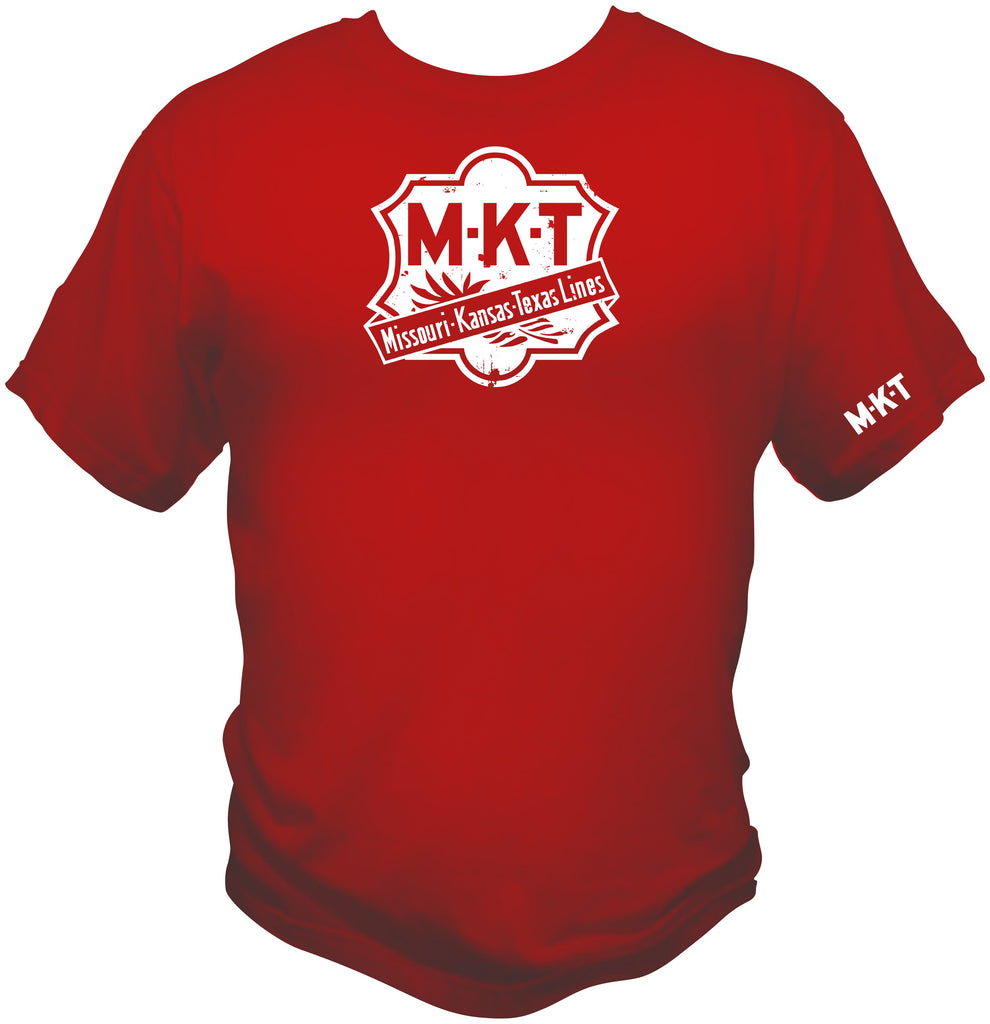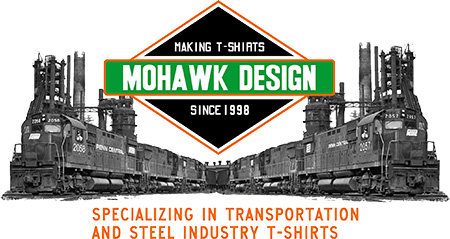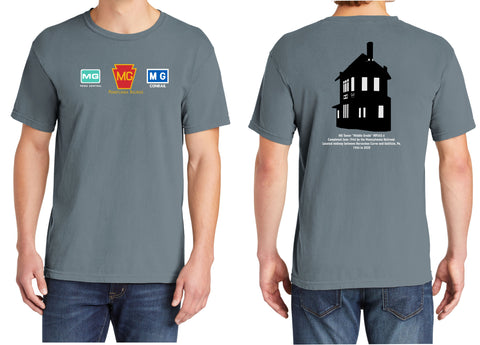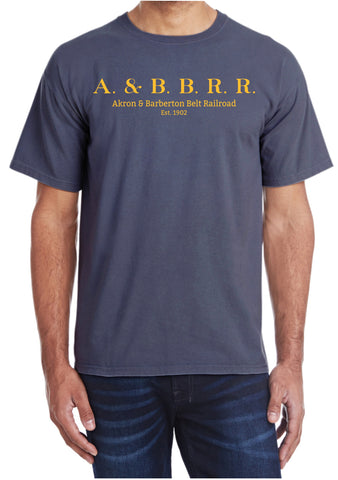
Missouri Kansas Texas (MKT) Faded Glory Shirt
Missouri Kansas Texas (MKT) Faded Glory Shirt
- Printed on Front
- 100% Cotton
- Shirt Color - MKT Red 100% cotton Comfort Color
The Missouri, Kansas & Texas Railway was incorporated in May 1870 in Junction City, Kansas. Ostensibly the original goal of the company was to build a supply railroad connecting the frontier military bases of Fort Riley, Fort Gibson and Fort Scott; and eventually Fort Worth; although its broader ambitions were to also connect to Chicago and New Orleans.[1] Upon its incorporation the MK&T acquired the Union Pacific Railway, Southern Branch (est. 1865) and its 182 miles (293 km) of track in Kansas. (Union Pacific Railway was, for a period of several years in the late 19th century, the official name of the unrelated Union Pacific Railroad, which later acquired MKT as part of the Missouri Pacific Railroad.)
At the time of its 1870 incorporation, consolidations were also made with the Labette & Sedalia Railway Co. and the Neosho Valley & Holden Railway Co.; MK&T also acquired the Tebo & Nosho Railroad Co., the St. Louis & Santa Fe Railroad Co., and the Hannibal & Central Missouri Railroad Co. Combined with the UP Southern Branch, these small, newly built railroads formed the foundation on which the Katy would build.
Congress had passed acts promising land grants to the first railroad to reach the Kansas border via the Neosho Valley. The Katy portion of the former UP Southern Branch, which had begun building from Fort Riley just north of Junction City, Kansas, was in a heated competition for the prize. On June 6, 1870, Katy workers laid the first rails across the Kansas border, winning the race. Congress' promised land grants were never made, as the courts overturned the grants because the land was in Indian Territory and was the property of the Indian tribes.
The Katy continued its push southward, laying track through the territory and reaching Texas in 1872, acquiring other small railroads while extending its reach to Dallas in 1886, Waco in 1888, Houston in April 1893 and to San Antonio in 1901.
Missouri-Kansas-Texas Railroad bridge over Red River (postcard, c. 1911)
Revenue freight traffic, in millions of net ton-miles[2]
Year Traffic
1925 3317
1933 1827
1944 7256
1960 3980
1970 4999
Source: ICC annual reports
When the Katy railroad reached Houston, its joint ownership of the Galveston, Houston and Henderson Railroad gave it immediate access to the Port of Galveston and its ocean-going shipping on the Gulf of Mexico.
In 1896, as a publicity stunt set up by William Crush, the Katy crashed two locomotives head-on, pulling loaded trains, at a site that came to be known thereafter as Crush, Texas. The collision occurred before more than 40,000 spectators, three of whom died (and several were injured) by debris from the exploding boilers. The ragtime composer and pianist Scott Joplin, who was performing in the area at the time, commemorated the event in his song "The Great Crush Collision March" (which he dedicated to the Missouri-Kansas-Texas Railway).[3]
In 1911, the MKT purchased railroad lines held by the industrialist Joseph A. Kemp of Wichita Falls, Texas. These included the Wichita Falls Railway, an 18-mile line between Wichita Falls and Henrietta in Clay County; the Wichita Falls and Northwest Railway Company of Texas; and the Wichita Falls and Wellington, which provided service into Wellington in Collingsworth County. Kemp's brother-in-law, Frank Kell, was a partner in some of these lines, including the Wichita Falls and Southern Railroad, which remained a Kemp-Kell property until it was abandoned in 1954.[4] In 1923, the Katy acquired another Kemp/Kell property, the Wichita Falls and Northwestern Railway, which extended from Wichita Falls to Forgan in the Oklahoma Panhandle. The route to Forgan, the Northwestern District of the MKT Railway, was abandoned in January 1973,[5] and Altus, Oklahoma, became the northern terminus of the branch. The remaining 77-mile link between Wichita Falls and Altus was absorbed in 1991 by the Wichita, Tillman and Jackson Railway.[6] The Katy acquired the Beaver, Meade and Englewood Railroad in 1931.[7] This trackage, like the length between Altus and Forgan, was abandoned in January 1973.[5]
From 1915 until January 4, 1959, the Katy, in a joint venture with the St. Louis – San Francisco Railway (popularly known as the Frisco), operated the Texas Special from St. Louis to Dallas, Ft. Worth, and San Antonio. It sported rail cars with names including Sam Houston, Stephen F. Austin, David Crockett, and James Bowie after prominent men of the state.
MKT #1006, a Baldwin DS-4-4-1000, on display in Parsons, Kansas.
On August 12, 1988 the Missouri Pacific Railroad (MoPac) and its owner, Union Pacific Corporation, purchased the Katy with approval from the Interstate Commerce Commission. The merging and restructuring of railroads during the 1980s had cost the Katy much overhead traffic, and it had been seeking a merger partner.[citation needed] On December 1, 1989 the Katy was merged into the MoPac, which is now part of the Union Pacific Railroad system.
In the "rails to trails" program, much of the Missouri track line has been adapted for use as the Katy Trail State Park, including a spur to Columbia, a Missouri State Park which runs along the Missouri River for the major portion of its route. In downtown Dallas, a 3.5-mile (6 km) long section called the Katy Trail is being converted into a multi-use trail linking White Rock Lake to the American Airlines Center.
In 1997 the segment linking Katy, Texas to downtown Houston was abandoned, and stripped of rails soon after. The section between Katy and Interstate 610 was purchased by the Texas Department of Transportation in 1998 for the expansion of Katy Freeway. The line that went into Houston was purchased by the city's Parks and Recreation Department. In 2009 it was adapted and paved as the Heights Bike Trail.
As part of a new heritage program, in July 2005 Union Pacific unveiled a new EMD SD70ACe locomotive, Union Pacific 1988, painted in traditional MKT colors.




